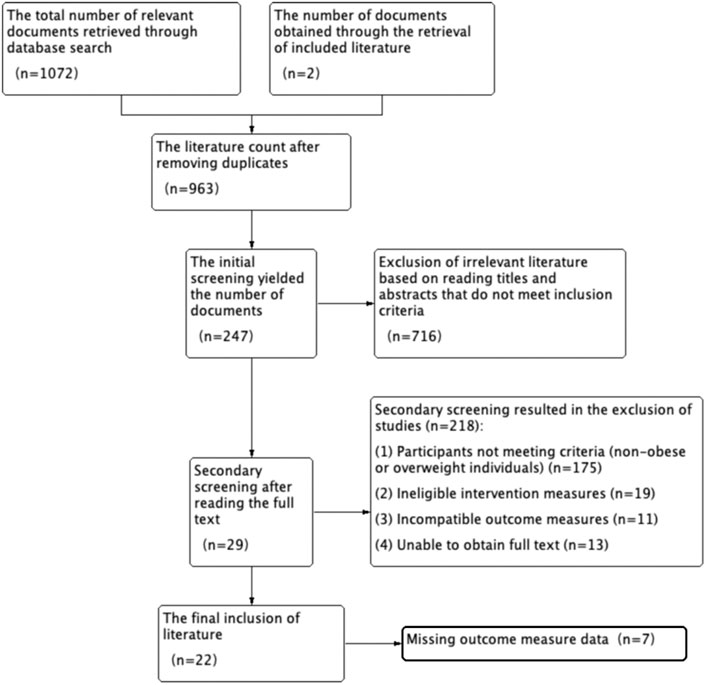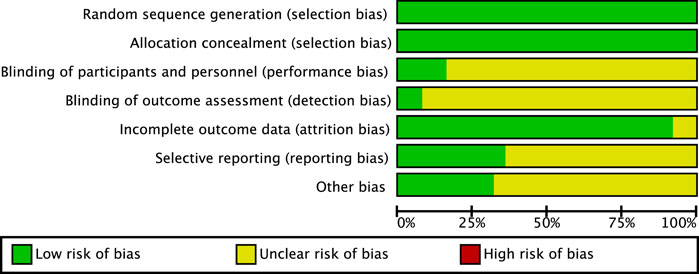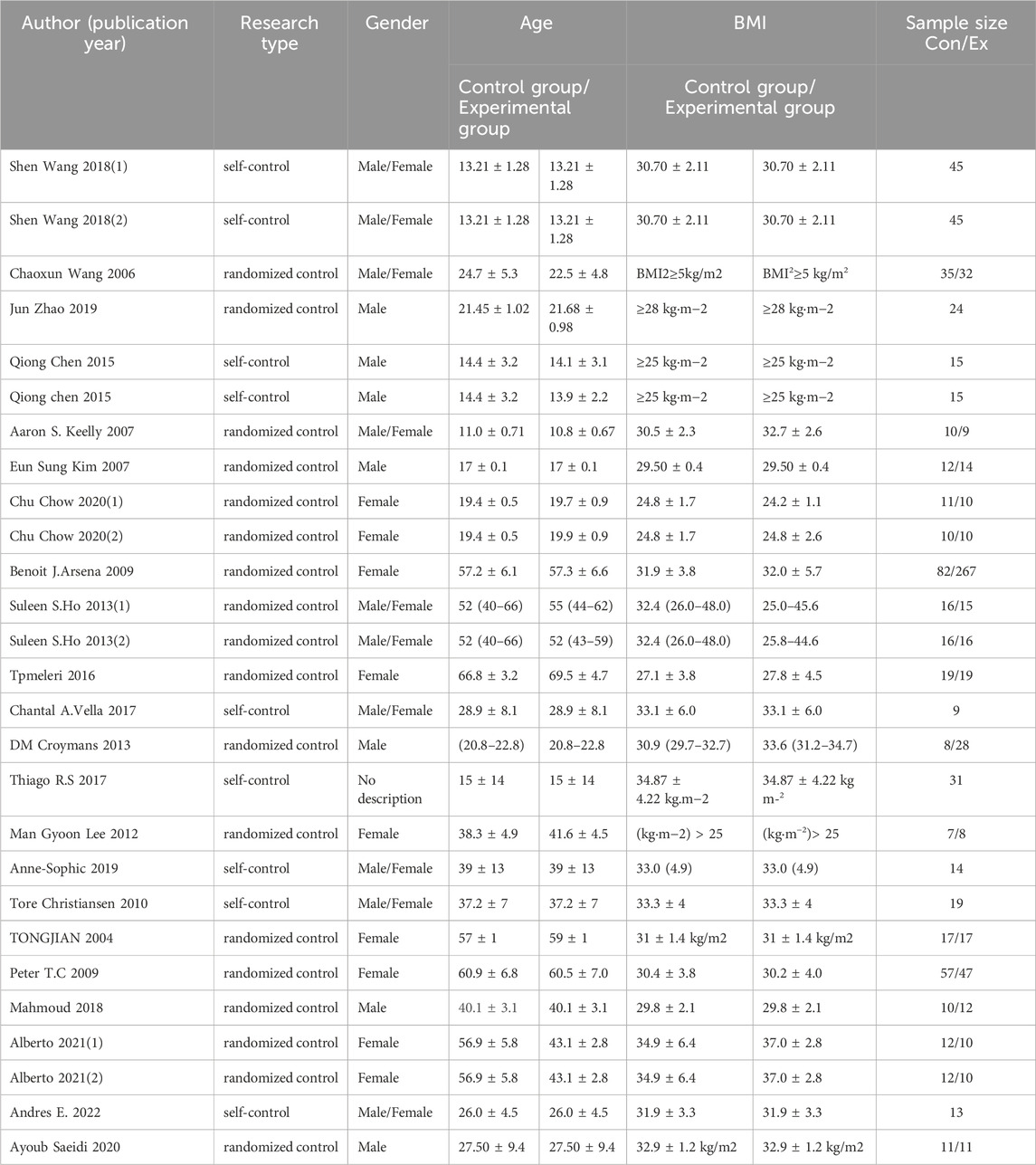- 1Capital University of Physical Education and Sports, Beijing, China
- 2Department of Physical Education, Hanyang University, Seoul, Republic of Korea
In the realm of obesity and overweight, the risk of chronic diseases significantly escalates, closely intertwined with inflammatory factors. Research suggests that specific exercise interventions, particularly aerobic exercise and resistance exercise, can have beneficial effects on inflammation levels. However, debates persist regarding the actual impact of exercise in the obese and overweight population. We employed meta-analysis research methods and searched the China National Knowledge Infrastructure Wanfang Data, PubMed, and Web of Science databases to gather controlled experiments on the effects of resistance exercise or aerobic exercise on C-reactive protein (CRP), interleukin-6 (IL-6), and tumor necrosis factor-alpha (TNF-α). Two researchers independently conducted literature screening and data extraction. The quality of the literature was assessed according to the Cochrane Handbook standards, and subgroup analyses of CRP, IL-6, and TNF-α were performed using RevMan 5.4 software. Through quantitative synthesis of results from 22 selected studies encompassing a total of 1,135 research subjects, this study systematically explored the specific regulatory effects of different exercise modalities on inflammatory markers in the obese and overweight population. The findings indicate that both aerobic exercise and resistance exercise effectively reduce CRP levels in obese individuals, with aerobic exercise demonstrating a more pronounced effect. Aerobic exercise also significantly lowers IL-6 levels, while the impact of resistance exercise on IL-6 is relatively minor. However, in terms of reducing TNF-α levels, neither modality appears to exert a significant effect. Overall, exercise, especially aerobic exercise, emerges as a positive regulator of inflammatory markers in the context of obesity and overweight.
1 Introduction
Obesity is widely recognized as a chronic metabolic disorder, with its prevalence showing a continuous upward trend globally (Ng et al., 2014). There is a close association between obesity and cardiovascular diseases, diabetes, fatty liver, and certain cancers. This association is not merely due to the mechanical burden of excess weight but more so because of the chronic inflammatory state caused by obesity. Insulin resistance and adipocyte proliferation caused by obesity lead to the secretion of inflammatory mediators by adipocytes, such as Interleukin-6 (IL-6), Tumor Necrosis Factor-alpha (TNF-α), and C-reactive protein (CRP). These three biomarkers play a crucial role in reflecting the body’s inflammatory state and overall health. When it comes to acute inflammatory markers, C-reactive protein (CRP) undoubtedly stands out as the most common. Levels of CRP rise rapidly during inflammation or tissue damage. Numerous studies have shown a strong correlation between elevated CRP levels and various diseases, including but not limited to cardiovascular diseases, diabetes, and obesity. Therefore, CRP is widely used to assess patients’ inflammatory status and disease risk (Ridker et al., 2002). On the one hand, Interleukin-6 (IL-6) is a crucial cytokine that plays a key role in the body’s immune response and inflammation processes. On the other hand, elevated levels of IL-6 are typically associated with chronic inflammatory conditions, such as obesity and metabolic syndrome. Additionally, IL-6 is involved in regulating blood sugar and lipid metabolism, closely linking it to the occurrence and development of various chronic diseases (Krogh-Madsen et al., 2004; Pedersen and Febbraio, 2008a). Lastly, High levels of TNF-α have been found to be associated with chronic diseases such as rheumatoid arthritis, inflammatory bowel disease, and cardiovascular diseases. Furthermore, TNF-α is also involved in the pathogenesis of obesity and metabolic syndrome, affecting the body’s metabolic status by regulating inflammation in adipose tissue and insulin resistance (Hotamisligil et al., 1993). At the same time, during adolescence and early adulthood (11–30 years old), the body undergoes significant physiological changes, including hormonal fluctuations and rapid growth (Patton et al., 2016). Generally, the overall level of inflammation during this stage is relatively low. Sex hormones such as estrogen and testosterone can influence the production and activity of inflammatory cytokines such as IL-6 and TNF-α. Additionally, young individuals typically have healthier lifestyles, including higher levels of physical activity and healthier dietary habits, which contribute to lower levels of inflammation (Park et al., 2012). During middle age (31–60 years old), the body’s physiological functions remain relatively stable, but there may be an onset of age-related chronic diseases. With advancing age, an increase in body fat content and a decline in metabolic function lead to a rise in low-level chronic inflammation. Individuals in this age group may experience higher levels of inflammatory markers due to factors such as insulin resistance and metabolic syndrome (Hotamisligil, 2006). Additionally, increased work stress and family responsibilities may also contribute to higher levels of inflammation (Kivimäki et al., 2000). In the elderly (65 years old and above), susceptibility to chronic diseases increases, and physiological function declines further, leading to a further increase in inflammation levels. As age increases, the deposition of abdominal fat and the prevalence of chronic diseases such as diabetes, cardiovascular disease, and arthritis rise, resulting in elevated systemic inflammation levels. Immune senescence is a significant factor, as changes in the aging immune system lead to the emergence of chronic low-level inflammation (Franceschi and Campisi, 2014). Current research on whether different types of exercise can reduce inflammatory marker levels remains highly debated. On one hand, a series of studies support the positive impact of exercise on reducing inflammatory markers in obese individuals. These exercise interventions include various forms such as aerobic exercise, resistance exercise, and others. These studies suggest that moderate and sustained exercise can modulate the immune system, alleviate chronic inflammation, and help improve metabolic conditions associated with obesity. For example, Chantal A. Vella et al. (2017) (Vella et al., 2017) conducted an 8-week trial intervention using aerobic exercise on obese individuals, with results indicating a significant reduction in CRP and IL-6, although TNF-α showed no significant change. Wang Chaoxun (2006) (Wang et al., 2006) conducted an 8-week intervention using aerobic exercise in obese and overweight individuals, revealing no significant changes in IL-6, but a decrease in CRP and TNF-α levels. Crisieli M. Tpmeleri (2016) (Tomeleri et al., 2016) employed anaerobic exercise in an 8-week trial intervention on obese or overweight individuals, demonstrating a significant decrease in CRP, IL-6, and TNF-α. On the other hand, a substantial body of research results indicates a lack of significant impact of exercise on inflammatory markers in obese and overweight populations. Aaron S. Keelly (2009) (Kelly et al., 2007a) and others conducted an 8-week aerobic exercise intervention on overweight individuals, with results showing no significant changes in CRP, IL-6, and TNF-α. Man Gyoon Lee (2012) (Lee et al., 2012) and colleagues conducted a 16-week aerobic exercise intervention in obese individuals, with no significant changes in CRP, IL-6, and TNF-α. Chen Qiong (2015) (Chen et al., 2015) utilized different types of resistance exercise for intervention in overweight individuals, resulting in a slight increase without significant reduction in the three markers. These experimental results are highly contentious, likely influenced by factors such as study design, sample characteristics, exercise intensity, measurement methods of inflammatory markers. Therefore, it is crucial to organize existing literature data to derive relatively consistent and rational research conclusions. This study aims to retrieve relevant previous research, employ meta-analysis methods, and systematically integrate and analyze data from the literature. The comprehensive evaluation of the impact of aerobic and resistance exercises on inflammatory marker levels in obese and overweight populations is intended to provide a reliable foundation for the development of more effective health intervention strategies for obese and overweight individuals.
2 Materials and methods
2.1 Literature sources and retrieval
The literature search covered the following databases: PubMed, Web of Science (utilizing both free-text and MeSH terms), China National Knowledge Infrastructure (CNKI), and Wanfang Database. The search spanned the last 2 decades and included the following search terms: inflammatory factors,” “C-reactive protein,” “tumor necrosis factor-alpha,” “interleukin-6,” “exercise,” “obesity,” “overweight,” “aerobic exercise,” “resistance exercise.” To ensure comprehensive retrieval, the search criteria also included “combination exercise. Language restrictions were set for Chinese and English, and the retrieval was concluded by 10 December 2023, adopting a retrospective method to ensure comprehensiveness.
2.2 Inclusion and exclusion criteria
Meta-analysis, a method pivotal in evidence-based medicine, leverages primary literature for statistical analysis to comprehend clinical issues. To elevate the quality of the included literature, this study adhered to the PICOS principle from Cochrane systematic reviews. PICOS encapsulates Population, Intervention, Comparison, Outcome, and Study design, long regarded as the gold standard for Meta-analysis. The inclusion and exclusion criteria based on PICOS for this study are as follows:
P (Population): Obese(BMI:>30.0) or overweight (BMI:25.0–29.9) individuals; Age:10–70age
I (Intervention): Intervention using aerobic or resistance exercise
C (Comparison): All types of comparisons/control, including self-control design
O (Outcome): CRP, IL-6, TNF-α
S (Study design): All types of comparisons/control, including self-control design
2.3 Article screening and data extraction
Researcher Guo and Xin extract basic information from the literature, including titles, publication years, author names, study designs, characteristics of study subjects, sample sizes, intervention details, sample sources, outcome indicators, and result information. Data extraction is conducted by Guo. When there is disagreement about including or excluding an article, researchers Guo and Xin discuss it, seeking consensus. If they cannot reach an agreement, they consult Liu and Qian. Liu makes the final decision based on their arguments.
Study design: Includes self-control and randomized controlled trials.
Characteristics of study subjects: Age, gender, BMI.
Intervention details: Experimental interventions using aerobic or resistance exercise, including intervention methods, duration, intensity, and primary exercise forms.
Outcome indicators and result information: CRP, IL-6, TNF-α.
2.4 Quality assessment
In Meta-analysis, the utilization of effective quality assessment methods allows for the evaluation of whether the study design and processes of included literature meet scientific standards. This study opted for the Cochrane standard for assessment, evaluating the risk of random sequence generation, allocation concealment, blinding of participants and personnel, blinding of outcome assessment, incomplete outcome data, selective reporting, and other biases for each item. A clear risk assessment was conducted for each item, categorized as high risk, low risk, or unclear, ensuring the credibility of the study and the scientific validity of the results.
2.5 Statistical analysis
Data analysis was conducted using Manager 5.4 (Review Manager Collaboration, 2020). Acknowledging potential differences between different experiments, the effect size in this study was represented by the Weighted Mean Difference (WMD), with a calculation of the 95% confidence interval. Heterogeneity in the study was measured using the consistency coefficient P and I2. Given statistical heterogeneity among study groups but not clinical heterogeneity, a random-effects model was applied, and subgroup analysis was performed to compare the impact of different exercise modes on inflammatory factors (CRP, IL-6, TNF-α). Sensitivity analysis was conducted to eliminate the influence of bias on the overall effect of individual studies showing differences.
3 Results
3.1 Literature search results
A total of 326 articles were retrieved from the Chinese database, and 746 articles from the English database, with an additional 2 articles supplemented through references identified during the search. In total, 1,072 articles were initially retrieved. After screening, a final selection of 26 articles was included (You et al., 2004; Wang et al., 2006; Kelly et al., 2007a; Kim et al., 2007; Arsenault et al., 2009; Campbell et al., 2009; Christiansen et al., 2010; Carrillo et al., 2012; Lee et al., 2012; Ho et al., 2013; Croymans et al., 2014; Chen et al., 2015; Tomeleri et al., 2016; Vella et al., 2017; Nikseresht, 2018; Tenório et al., 2018; Wang et al., 2018; Wedell-Neergaard et al., 2019; Zhao and Liang, 2019; Chow et al., 2021; Pérez-López et al., 2022; Saeidi et al., 2023), comprising 18 in English and 4 in Chinese(All are Chinese Core Journals). The literature selection process is illustrated in Figure 1. Relevant literature was obtained through database searches (n = 1,072), with an additional 2 articles identified through references in the selected literature. After removing duplicate articles (n = 963), a thorough review of full texts and titles resulted in the inclusion of 247 studies. Subsequent screening of full texts (n = 29) led to the exclusion of 218 studies for various reasons: mismatched study subjects (n = 175), inappropriate intervention measures (n = 19), incongruent outcome indicators (n = 11), and unavailability of full texts (n = 13). A final screening of experimental data related to outcome indicators was performed (n = 7), resulting in the ultimate inclusion of 22 articles.
3.2 Quality assessment results
This study incorporates 22 research articles, and each article was evaluated according to Cochrane standards, as shown in Figure 2 and Figure 3. Among the 26 studies, 7 employed self-control (Christiansen et al., 2010; Carrillo et al., 2012; Chen et al., 2015; Vella et al., 2017; Tenório et al., 2018; Wang et al., 2018; Wedell-Neergaard et al., 2019) while 19 adopted random control (Wang et al., 2006; Kelly et al., 2007a; Kim et al., 2007; Arsenault et al., 2009; Campbell et al., 2009; Carrillo et al., 2012; Lee et al., 2012; Ho et al., 2013; Croymans et al., 2014; Tomeleri et al., 2016; Nikseresht, 2018; Zhao and Liang, 2019; Chow et al., 2021; Pérez-López et al., 2022; Saeidi et al., 2023). The evaluation results reveal that all included articles mention the generation and concealed allocation of random sequences, categorizing them as low risk. Additionally, 4 articles (Carrillo et al., 2012; Croymans et al., 2014; Tenório et al., 2018; Wedell-Neergaard et al., 2019) provide detailed descriptions of double-blinding between implementers and participants. Due to variations in intervention intensity or the use of placebos, detecting subtle changes in movement intensity is challenging. However, in other studies where interventions involve only two different exercises or a single exercise, implementing blinding becomes difficult, making it challenging to avoid revealing the study’s purpose. Nine studies reported participant dropouts, but all were deemed low risk as the dropouts were unrelated to the experimental intervention. Regarding outcome indicators, most articles did not explicitly specify them. Therefore, studies with unclear outcome descriptions were considered unclear.
Note:
1. Generation of random sequence (selection bias);
2. Allocation concealment (selection bias);
3. Double-blinding of implementers and participants (implementation bias);
4. Blinding in outcome assessment (detection bias);
5. Incomplete outcome data (attrition bias);
6. Selective reporting (reporting bias);
7. Other biases (excluding other important biases in the biases mentioned above).
3.3 Basic characteristics of included studies
This meta-analysis includes a total of 22 studies, as shown in Table 1 and Table 2, comprising 4 published in Chinese core journals and 18 in English, spanning from 2003 to 2023. The total number of participants across these studies is 1,135, with a wide age range. Participants predominantly have elevated body fat levels, indicating characteristics of obesity and overweight. The majority of intervention durations in the included studies were 12 weeks, with only one study having an intervention lasting less than 8 weeks (Kim et al., 2007), and the longest intervention period reaching 1 year (12 months) (Campbell et al., 2009).
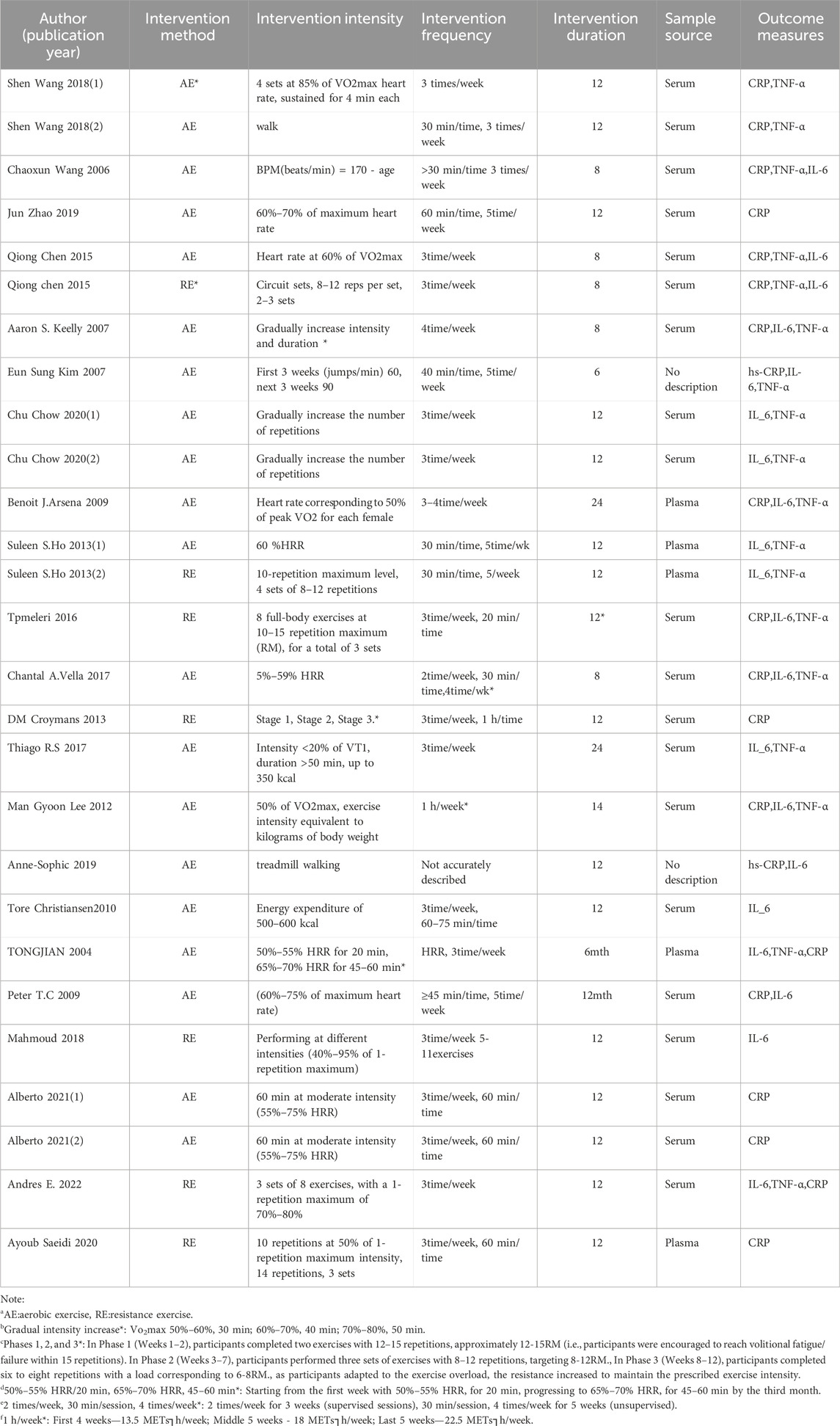
Table 2. Overview of research methodology design and outcome measures in included literature for meta-analysis.
Aerobic exercise interventions primarily involved cycling and running/walking, while resistance exercise interventions mainly utilized resistance machines and bench presses. Thirteen studies incorporated running and cycling in aerobic exercise interventions, and five studies focused on bench presses in resistance exercise interventions. Some studies also included variations in aerobic and resistance exercise modes. This meta-analysis investigated the impact of aerobic exercise or resistance exercise on CRP levels, incorporating a total of 17 studies. Additionally, the effects of aerobic exercise and resistance exercise on IL-6 and TNF-α levels were examined, including 17 studies and 14 studies, respectively.
In these studies, the intensity and dose of aerobic exercise varied, typically involving moderate to high intensity, performed 3–5 times per week, with each session lasting 30–60 min. The intensity and dose of resistance exercise also varied, generally involving moderate to high intensity, performed 2–3 times per week, with each session comprising 8–12 different resistance exercises, each set repeated 8–12 times.
(7) 12-week intervention period: 8 weeks of experimentation +4 weeks of measurement, totaling 12 weeks
3.4 Meta-analysis
3.4.1 CRP
CRP is a common inflammatory marker, and elevated levels of CRP areclosely associated with increased risk of atherosclerosis and cardiovascular events. In Figure 4, in terms of CRP data, 17 studies involving a total of 959 participants were included in the analysis. A random-effects model was employed to study the impact of different exercise modalities on CRP levels in the obese and overweight population, revealing high heterogeneity among the studies (I2 = 85%, p < 0.00001). Using a random-effects model, the pooled effect size was [SMD = −0.70, 95% CI = −1.07 to −0.33 (p = 0.0002)], indicating that exercise can reduce CRP levels in the obese and overweight population to a certain extent. Subgroup analysis showed that AE [SMD = −0.63, 95% CI = −1.07 to −0.18, (p = 0.005)] and RE [SMD = −0.92, 95% CI = −1.58 to −0.25, (p = 0.007)] significantly lowered CRP levels in the obese and overweight population. The subgroup analysis results indicated that both aerobic and resistance exercises could significantly reduce CRP levels in the obese and overweight population, with the former showing a more pronounced regulatory effect on CRP.
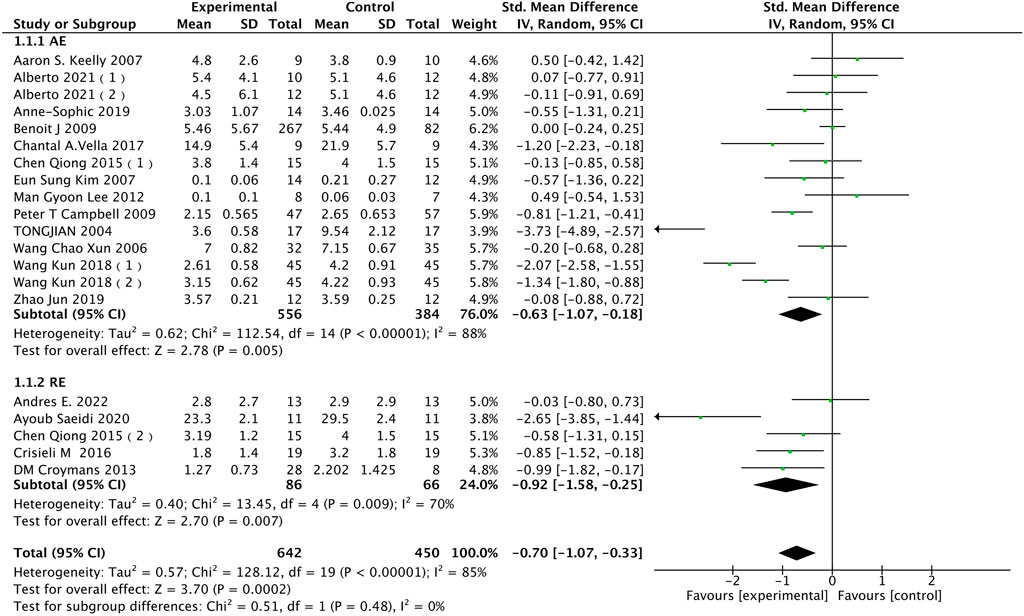
Figure 4. Subgroup analysis of the influence of various exercise modalities on CRP in the obese population.
3.4.2 IL-6
In the context of IL-6, as shown in Figure 5, this study includes 17 research articles with a total of 917 participants. Analyzing the impact of different exercise modalities on IL-6 levels in the obese and overweight population reveals high heterogeneity among the studies (I2 = 77%, p < 0.00001). Using a random-effects model, the pooled effect size is [SMD = −0.34, 95% CI = −0.64 to −0.03 (p = 0.03)], indicating that exercise can moderately reduce IL-6 levels in the obese and overweight population. The subgroup analysis results indicate that AE can effectively reduce IL-6 levels in the obese and overweight population(SMD = −0.42, 95% CI = −0.81 to −0.03, p = 0.03), while the impact of RE on IL-6 levels in the obese population is not significant(SMD = −0.19, 95% CI = −0.52 to 0.13, (p = 0.25)).
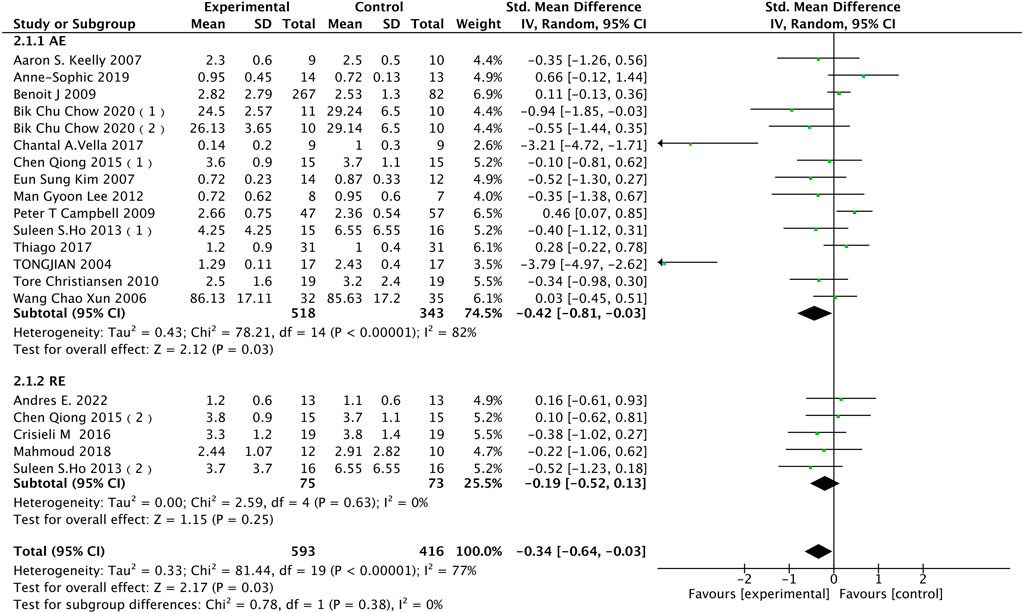
Figure 5. Subgroup analysis of the effects of different exercise modalities on IL-6 in the obese population.
Caption: Compared to pre-exercise intervention levels, AE effectively reduces interleukin-6 levels, while the impact of RE on interleukin-6 levels reduction is not significant (p = 0.03/p = 0.25).
3.4.3 TNF-α
Tumor necrosis factor-alpha (TNF-α) is an inflammatory mediator typically associated with inflammation and immune responses. Exercise has complex effects on the immune system and inflammatory responses, often considered to have a regulatory impact on certain inflammation markers. As shown in Figure 6, in terms of TNF-α data, 14 studies involving a total of 835 participants were included in the analysis. Using a random-effects model to study the impact of different exercise modalities on TNF-α levels in the obese and overweight population, high heterogeneity was observed among the studies (I2 = 87%, p < 0.00001). Applying the random-effects model, the pooled effect size was [SMD = −0.06, 95% CI = −0.47 to 0.35 (p = 0.78)], indicating that exercise has no significant effect on reducing TNF-α levels in the obese and overweight population. Subgroup analysis showed that AE [SMD = −0.14, 95% CI = −0.64 to 0.36, (p = 0.59)] and RE [SMD = 0.21, 95% CI = −0.24 to 0.67, (p = 0.36)]. There was no significant effect on reducing TNF-α levels in the obese and overweight population.
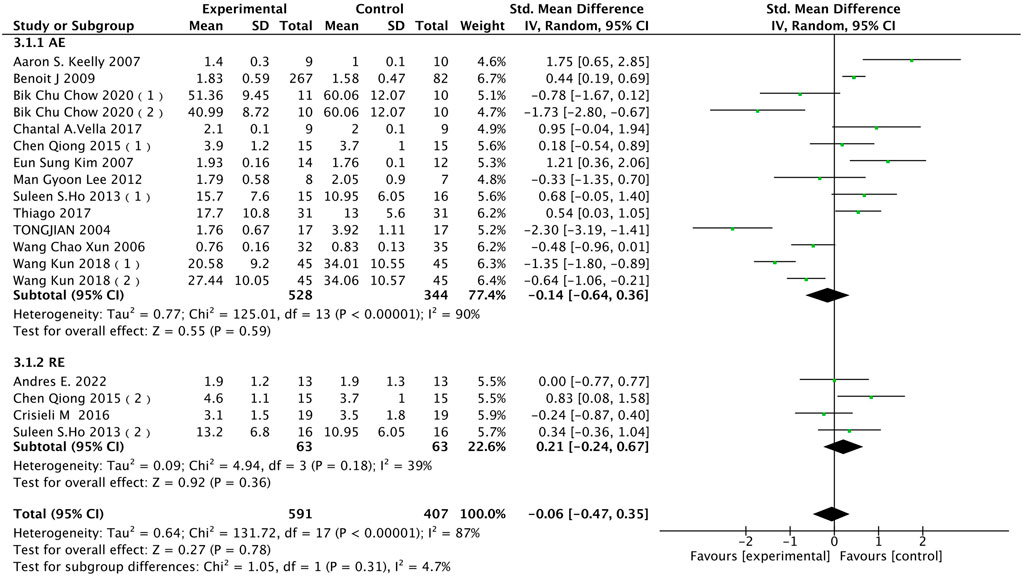
Figure 6. Subgroup analysis of the impact of Diverse exercise modalities on TNF-α in the obese population.
Caption: Compared to pre-exercise intervention levels, both AE and RE show no significant effect on reducing TNF-α levels (p = 0.59/p = 0.36).
3.5 Publication bias and sensitivity analysis
The evaluation of publication bias in the Revman software is presented through a funnel plot. In this study, funnel plots were constructed with the standard error (logarithm of SMD) on the x-axis and the standard error of SMD (SE(SMD)) on the y-axis. Funnel plots of the effects of aerobic exercise on CRP, IL-6, and TNF-α are presented below. The publication bias of different exercise modes on CRP in obese and overweight populations is shown in Figure 7: the majority of the scattered points are concentrated in the middle of the graph, distributed relatively symmetrically. However, two studies are located in the bottom left corner, suggesting potential publication bias. Sensitivity analysis was conducted, and after removing some literature (You et al., 2004; Wang et al., 2018), the results showed that the for aerobic exercise (AE) decreased to over 50%, while resistance exercise (RE) decreased to over 20%, with no significant difference in results observed. The funnel plot for IL-6 (Figure 8) demonstrates that the scattered points of each study are concentrated, but two study is located in the bottom left corner, indicating potential publication bias. After literature exclusion (You et al., 2004; Vella et al., 2017), the for AE decreased to over 50%, with no change in results observed. The TNF-α funnel plot (Figure 9) shows that the studies are concentrated with significant symmetry on both sides, indicating no apparent publication bias. Regarding the bias of the above indicators, we isolated and excluded these studies before re-conducting the meta-analysis. Compared to previous research results, no significant changes were found. The effect sizes still had statistical significance, demonstrating the reliability of the previous analysis conclusions. If you are preparing this for submission to an English journal, I can help you further refine and polish it.
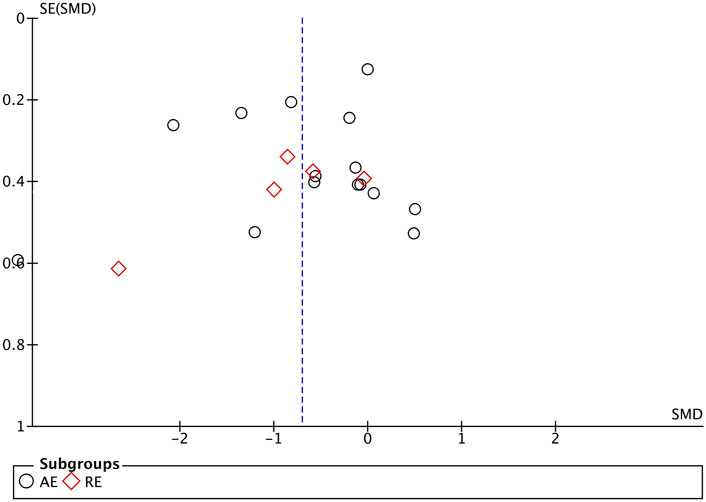
Figure 7. Funnel Plot Illustrating the Impact of Different Exercise Modalities on CRP in the obese and overweight Population.
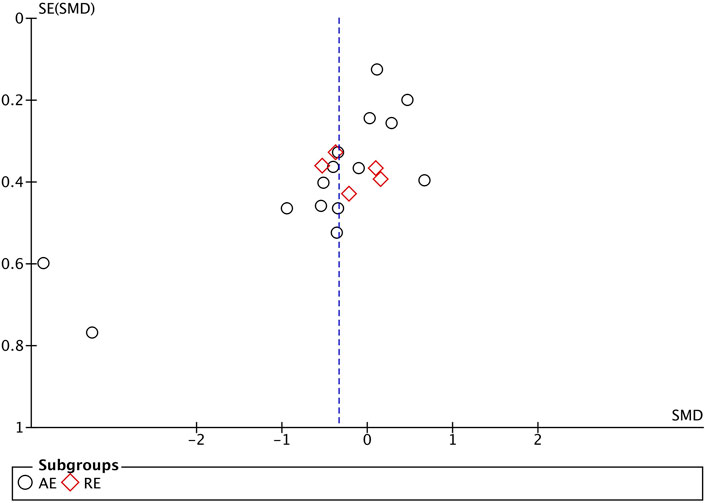
Figure 8. Funnel Plot illustrating the impact of different exercise modalities on IL-6 in the obese and overweight population.
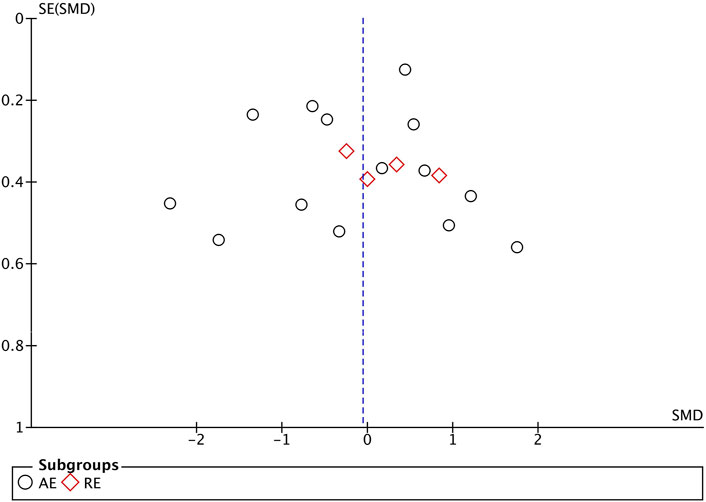
Figure 9. Funnel Plot Illustrating the Impact of Various Exercise Modes on TNF-α in the obese and overweight Population.
3.6 Summary of meta-analysis results
Initially, looking at the overall results, both aerobic exercise and resistance exercise appear to reduce CRP levels in obese and overweight populations, with aerobic exercise demonstrating a more pronounced effect in lowering CRP. Additionally, aerobic exercise effectively lowers IL-6 levels in obese and overweight individuals, while resistance exercise shows no significant impact on reducing IL-6. Both aerobic and resistance exercises seem to have no significant effect on lowering TNF-α levels in obese and overweight populations. Despite the possibility of high heterogeneity among the included studies, sensitivity analysis indicates that the results remain stable and reliable. In the summary of the inflammatory factor studies, no single study was found to exert a disproportionately large influence on the overall results. The inclusion criteria for the studies were met uniformly, and heterogeneity may stem from variations in exercise intensity and volume or potential age and gender differences. Therefore, this study employed the standardized mean difference (SMD) and a random-effects model to minimize the impact of literature heterogeneity on the results.
4 Discussion
It is widely recognized that individuals with obesity and overweight, especially those with excessive accumulation of visceral fat, often generate pro-inflammatory cytokines, which may significantly trigger systemic inflammation (Fried et al., 1998; Harkins et al., 2004). Mild chronic inflammation is often closely associated with excessive caloric intake and a lack of physical activity. Tumor necrosis factor-alpha (TNF-α), interleukin-6 (IL-6), and C-reactive protein (CRP) are closely linked to this condition. Meta-analysis of inflammatory marker data from study subjects suggests that exercise significantly reduces CRP and IL-6 levels in obese populations, aligning with previous research. Surprisingly, exercise shows no significant impact on lowering TNF-α levels, which may involve differences in biological mechanisms or study design. Subgroup analysis of different exercise modalities indicates that aerobic exercise can significantly reduce CRP and IL-6 levels in obese and overweight individuals. Some studies have indicated that aerobic exercise can increase the activity of the vagus nerve, thereby enhancing anti-inflammatory effects (Tracey, 2002), a study conducted by Kevin Tracey’s laboratory precisely illustrates this point. Aerobic exercise can increase the activity of the vagus nerve, thus reducing inflammation. This mechanism may be achieved through the neuro-immune regulation between the vagus nerve and the inflammatory response. As reported by Taaffe et al., IL-6 and CRP decrease with increased moderate and high-intensity physical activity (Taaffe et al., 2000). Interestingly, the meta-analysis results reveal that aerobic exercise has a more pronounced effect on reducing CRP levels compared to resistance exercise, which may be attributed to several key physiological mechanisms. Firstly, aerobic exercise can improve blood glucose control and increase insulin sensitivity, significantly reducing insulin resistance and consequently lowering inflammation levels, such as Colberg (2016) and Pedersen (2015) (Pedersen and Febbraio, 2012; Colberg, 2016). Additionally, aerobic exercise influences the inflammatory state by regulating hormone levels, such as reducing tumor necrosis factor-alpha (TNF-α) and interleukin-1β (IL-1β), while promoting the production of more anti-inflammatory hormones, such as interleukin-10 (IL-10). This helps to balance the activity of the immune system, thereby reducing the inflammatory response (Pedersen and Febbraio, 2008b). Other studies, such as Del Rosso 2023 Obes Rev, indicate that resistance exercise (RE) also impacts IL-6 levels. Good vascular health is also one of the significant effects of aerobic exercise. Through various physiological mechanisms such as increasing cardiac contractility, improving cardiac output, and increasing the release of nitric oxide by endothelial cells, aerobic exercise can improve endothelial function, increase vascular elasticity, reduce the risk of atherosclerosis and inflammation, decrease vascular inflammatory responses and endothelial cell damage, thus lowering CRP levels (Green et al., 1985). Furthermore, aerobic exercise promotes the oxidative metabolism of fatty acids within fat cells, reducing the release of interleukin-6 (IL-6) from fat cells, further lowering CRP levels. The combined effects of these physiological responses may explain why aerobic exercise demonstrates more significant reductions in CRP and IL-6 levels. Additionally, the analysis results show that resistance exercise has minimal fluctuations in IL-6 levels, but overall, the actual impact is not significant, consistent with the findings of Wang Chaoxun (2006) (Wang et al., 2006). Furthermore, aerobic exercise is typically associated with a high number of submaximal muscle contractions, whereas resistance exercise emphasizes short-duration, high-intensity muscle contractions. This difference might result in insufficient mechanical stimulation during resistance exercise to significantly impact the release of interleukin-6 (IL-6). Additionally, aerobic exercise is commonly accompanied by substantial oxidative glycogen utilization, while resistance exercise may rely more on the phosphagen system. IL-6 production is closely linked to glycogen consumption and metabolic status, potentially leading to a relatively minor influence of resistance exercise on IL-6. It is noteworthy that neither aerobic nor resistance exercise exhibits a significant regulatory effect on TNF-α levels in obese and overweight populations. Specifically, the study by Colbert et al. (Harris, 2004) found a negative correlation between individual activity levels and CRP, iIL-6, and TNF-α. Higher activity levels were associated with lower levels of inflammatory markers, but the study also discovered that the correlation between activity levels and TNF-α became non-significant after intervening with obesity factors. In a subsequent study by Beavers et al. (2010) (Beavers et al., 2010), examining a broader range of inflammatory biomarkers in the same cohort, TNF-α remained unaffected. Similarly, in the study by Chen Qiong (2015) (Chen et al., 2015), TNF-α levels slightly increased in obese and overweight individuals after 8 weeks of resistance exercise, possibly due to induced muscle microdamage and fatigue (Cheung et al., 2003). Moreover, CRP and IL-6 exhibit higher sensitivity compared to TNF-α. The lack of TNF-α elevation may also be associated with the duration of exercise, as most studies (Hammett et al., 2004; Kohut et al., 2006; Nicklas et al., 2008; Vieira et al., 2009) show a reduction in systemic inflammatory markers after at least 24 weeks of intervention, while shorter intervention durations (less than 24 weeks) have no significant impact on inflammatory markers [ (Colbert et al., 2004; Martins et al., 2010)].
Furthermore, within the confines of this study, there is notable heterogeneity observed in the levels of CRP, TNF-α, and IL-6. This complex scenario may be attributed to an array of factors, including a substantial age range, gender diversities, and variances in intervention intensity and duration. These multifaceted factors could introduce latent variables that exert influence on the observed outcomes. Primarily, the diversity in age emerges as a pivotal factor contributing significantly to the discerned heightened heterogeneity. Participants spanning different age cohorts may find themselves in disparate physiological states. For instance, elderly individuals undergo the rigors of physiological aging, resulting in a discernible decline in immune system functionality (Larbi et al., 2008). In contrast, their younger counterparts may revel in a state of physiological vitality, maintaining a relatively robust immune profile. Such variances in physiological states are likely to impinge upon baseline levels of inflammatory markers and the nuanced response to exercise interventions (Woods et al., 2012). Furthermore, the nuanced age-related variations in the sensitivity of the anti-inflammatory system may contribute to disparate responses to identical interventions. As individuals progress in age, there is a gradual attenuation of immune function, instigating the progression of inflammatory processes (Colbert et al., 2004). Even under ostensibly healthy conditions, older individuals manifest a 2-4-fold elevation in pro-inflammatory cytokines and acute-phase proteins when compared to their younger counterparts (Bruunsgaard and Pedersen, 2003). Simultaneously, gender-based disparities emerge as another prominent source of heightened heterogeneity. Within the In CHIANTI study, the engagement in walking activities for 2–4 h per week demonstrated an association with diminished CRP levels among males and a concomitant reduction in IL-6 levels among females (Elosua et al., 2005).
Albert et al., in their thorough investigation, found that even after thorough adjustments for BMI and other cardiovascular risk factors, a residual negative correlation between CRP and male physical activity persisted, while the relationship between physical activity and female CRP levels remained subtle (Albert et al., 2004). Furthermore, insights garnered from a comprehensive study conducted by Aaron S. Kelly (2007)indicate that a condensed 8-week regimen of physical activity might potentially suffer from brevity or subdued intensity, rendering it challenging to incite discernible enhancements in adipose factors and oxidative stress reactions (Kelly et al., 2007a), This kind of brief or low-intensity exercise may lead to reduced exercise effectiveness. A shorter exercise period may fail to fully activate the metabolic pathways within fat cells, thus inadequately reducing the release of fat factors and limiting metabolic changes in the body, thereby restricting its impact on inflammation, and may even fail to induce sufficient physiological changes (Kim et al., 2006). Generally, physical exercise requires sufficient time to trigger adaptive responses in the body, especially in improving metabolic function and reducing inflammation. Additionally, a shorter exercise duration may also fail to provide enough mechanical stimulation, which is particularly important in resistance exercise, as moderate muscle stimulation can promote muscle adaptive responses (Kelly et al., 2007b). Conversely, a longer exercise period may provide more opportunities to gradually increase exercise loads and allow the body to adapt to more physiological changes. In long-term exercise, the body may gradually adjust metabolic pathways, enhance anti-inflammatory mechanisms, and improve tissue health (Gleeson et al., 2011). Therefore, compared to short-term exercise, long-term exercise may produce more sustainable and significant effects (Schoenfeld et al., 2017). Compelling evidence substantiates the dichotomous impact of exercise on inflammation, whereby heightened intensity in acute exercise may precipitate muscular damage, particularly in instances of prolonged and intense workouts, thereby eliciting inflammatory cell infiltration and elevated levels of muscle-specific creatine kinase subtypes (Clarkson and Hubal, 2002). Noteworthy, Taaffe et al. brought to light an intriguing inverse correlation between walking speed and IL-6 and CRP levels (Shoelson and Lee, 2006). Consequently, disparities in exercise intensity and duration could feasibly contribute to the augmented heterogeneity observed in research outcomes.
5 Conclusion
Based on evidence from experimental interventions employing both pre-post self-control and randomized control trials, it is indicated that both aerobic exercise and resistance exercise can reduce CRP levels in obese individuals, with aerobic exercise showing a more pronounced effect. Additionally, aerobic exercise has been demonstrated to effectively lower IL-6 levels, whereas resistance exercise does not exhibit a significant impact on IL-6 levels in obese populations. In the literature reviewed, neither aerobic nor resistance exercise shows a significant reduction in IL-6 and TNF-α levels in the human body. Further support for these findings could be derived from additional high-quality studies in the future.
6 Limitations of this study
This study followed the prescribed procedures outlined by the PRISMA guidelines. However, due to the wide standard deviation in the age range of participants included in the literature, it was not possible to conduct subgroup analyses regarding the impact of different age groups on inflammatory factors. The sensitivity of the anti-inflammatory system, influenced by age, resulted in varying outcomes for the same indicators following exercise interventions, introducing a certain level of heterogeneity in the results. Moreover, differences in intervention intensity and duration may have exposed the study to the influence of undisclosed factors, potentially contributing to an elevated level of heterogeneity.
Author contributions
YG: Data curation, Formal Analysis, Methodology, Supervision, Writing–original draft, Writing–review and editing. XX: Data curation, Formal Analysis, Writing–review and editing. HQ: Data curation, Formal Analysis, Methodology, Writing–review and editing. LQ: Formal Analysis, Supervision, Validation, Writing–review and editing.
Funding
The author(s) declare that no financial support was received for the research, authorship, and/or publication of this article.
Conflict of interest
The authors declare that the research was conducted in the absence of any commercial or financial relationships that could be construed as a potential conflict of interest.
Publisher’s note
All claims expressed in this article are solely those of the authors and do not necessarily represent those of their affiliated organizations, or those of the publisher, the editors and the reviewers. Any product that may be evaluated in this article, or claim that may be made by its manufacturer, is not guaranteed or endorsed by the publisher.
References
Albert M. A., Glynn R. J., Ridker P. M. (2004). Effect of physical activity on serum C-reactive protein. Am. J. Cardiol. 93 (2), 221–225. doi:10.1016/j.amjcard.2003.09.046
Arsenault B. J., Côté M., Cartier A., Lemieux I., Després J. P., Ross R., et al. (2009). Effect of exercise training on cardiometabolic risk markers among sedentary, but metabolically healthy overweight or obese post-menopausal women with elevated blood pressure. Atherosclerosis 207 (2), 530–533. doi:10.1016/j.atherosclerosis.2009.05.009
Beavers K. M., Hsu F. C., Isom S., Kritchevsky S. B., Church T., Goodpaster B., et al. (2010). Long-term physical activity and inflammatory biomarkers in older adults. Med. Sci. Sports Exerc. 42 (11), 2189–2196. doi:10.1249/MSS.0b013e3181e3ac80
Bruunsgaard H., Pedersen B. K. (2003). Age-related inflammatory cytokines and disease. Immunol. Allergy Clin. N. Am. 23 (1), 15–39. doi:10.1016/S0889-8561(02)00056-5
Campbell P. T., Campbell K. L., Wener M. H., Wood B. L., Potter J. D., McTiernan A., et al. (2009). A yearlong exercise intervention decreases CRP among obese postmenopausal women. Med. Sci. Sports Exerc. 41 (8), 1533–1539. doi:10.1249/MSS.0b013e31819c7feb
Carrillo A. E., Flynn M. G., Pinkston C., Markofski M. M., Jiang Y., Donkin S. S., et al. (2012). Vitamin D supplementation during exercise training does not alter inflammatory biomarkers in overweight and obese subjects. Eur. J. Appl. Physiology 112 (8), 3045–3052. doi:10.1007/s00421-011-2279-3
Chen Q., Cao J., Zhao L. I., Yi N. (2015). Effects of different exercise modes on body composition, inflammatory factors, and exercise capacity of obese teenagers. J. Jilin Univ. Ed. 41 (05), 1070–1075.
Cheung K., Hume P., Maxwell L. (2003). Delayed onset muscle soreness: treatment strategies and performance factors. Sports Med. Auckl. N.Z. 33 (2), 145–164. doi:10.2165/00007256-200333020-00005
Chow B. C., Li S., Zhu X., Jiao J., Quach B., Baker J. S., et al. (2021). Effects of descending or ascending stair exercise on body composition, insulin sensitivity, and inflammatory markers in young Chinese women with obesity: a randomized controlled trial. J. Sports Sci. 39 (5), 496–502. doi:10.1080/02640414.2020.1829362
Christiansen T., Paulsen S. K., Bruun J. M., Pedersen S. B., Richelsen B. (2010). Exercise training versus diet-induced weight-loss on metabolic risk factors and inflammatory markers in obese subjects: a 12-week randomized intervention study. Am. J. Physiology. Endocrinol. Metabolism 298 (4), E824–E831. doi:10.1152/ajpendo.00574.2009
Clarkson P. M., Hubal M. J. (2002). Exercise-induced muscle damage in humans. Am. J. Phys. Med. Rehabilitation 81 (11), S52–S69. doi:10.1097/00002060-200211001-00007
Colberg S. R. (2016). Physical activity: the forgotten tool for type 2 diabetes management. Front. Endocrinol. 7, 142.
Colbert L. H., Visser M., Simonsick E. M., Tracy R. P., Newman A. B., Kritchevsky S. B., et al. (2004). Physical activity, exercise, and inflammatory markers in older adults: findings from the Health, Aging and Body Composition Study. J. Am. Geriatrics Soc. 52 (7), 1098–1104. doi:10.1111/j.1532-5415.2004.52307.x
Croymans D. M., Krell S. L., Oh C. S., Katiraie M., Lam C. Y., Harris R. A., et al. (2014). Effects of resistance training on central blood pressure in obese young men. J. Hum. Hypertens. 28 (3), 157–164. doi:10.1038/jhh.2013.81
Elosua R., Bartali B., Ordovas J. M., Corsi A. M., Lauretani F., Ferrucci L., et al. (2005). Association between physical activity, physical performance, and inflammatory biomarkers in an elderly population: the InCHIANTI study. Journals Gerontology Ser. A Biol. Sci. Med. Sci. 60 (6), 760–767. doi:10.1093/gerona/60.6.760
Franceschi C., Campisi J. (2014). Chronic inflammation (inflammaging) and its potential contribution to age-associated diseases. Journals Gerontology Ser. A Biomed. Sci. Med. Sci. 69 (Suppl. l_1), S4–S9. doi:10.1093/gerona/glu057
Fried S. K., Bunkin D. A., Greenberg A. S. (1998). Omental and subcutaneous adipose tissues of obese subjects release interleukin-6: depot difference and regulation by glucocorticoid. J. Clin. Endocrinol. Metabolism 83, 847–850. doi:10.1210/jcem.83.3.4660
Gleeson M., Bishop N. C., Stensel D. J., Lindley M. R., Mastana S. S., Nimmo M. A. (2011). The anti-inflammatory effects of exercise: mechanisms and implications for the prevention and treatment of disease. Nat. Rev. Immunol. 11 (9), 607–615. doi:10.1038/nri3041
Green D. J., O’Driscoll G., Joyner M. J., Cable N. T. (1985)2008). Exercise and cardiovascular risk reduction: time to update the rationale for exercise? J. Appl. Physiol. 105 (2), 766–768. doi:10.1152/japplphysiol.01028.2007
Hammett C. J. K., Oxenham H. C., Baldi J. C., Doughty R. N., Ameratunga R., French J. K., et al. (2004). Effect of six months’ exercise training on C-reactive protein levels in healthy elderly subjects. J. Am. Coll. Cardiol. 44 (11), 2411–2413. doi:10.1016/j.jacc.2004.09.030
Harkins J. M., Moustaid-Moussa N., Chung Y. J., Penner K. M., Pestka J. J., North C. M., et al. (2004). Expression of interleukin-6 is greater in preadipocytes than in adipocytes of 3T3-L1 cells and C57BL/6J and ob/ob mice. J. Nutr. 134 (10), 2673–2677. doi:10.1093/jn/134.10.2673
Ho S. S., Dhaliwal S. S., Hills A. P., Pal S. (2013). Effects of chronic exercise training on inflammatory markers in Australian overweight and obese individuals in a randomized controlled trial. Inflammation 36 (3), 625–632. doi:10.1007/s10753-012-9584-9
Hotamisligil G. S. (2006). Inflammation and metabolic disorders. Nature 444 (7121), 860–867. doi:10.1038/nature05485
Hotamisligil G. S., Shargill N. S., Spiegelman B. M. (1993). Adipose expression of tumor necrosis factor-alpha: direct role in obesity-linked insulin resistance. Science 259 (5091), 87–91. doi:10.1126/science.7678183
Kelly A. S., Steinberger J., Olson T. P., Dengel D. R. (2007a). In the absence of weight loss, exercise training does not improve adipokines or oxidative stress in overweight children. Metabolism 56 (7), 1005–1009. doi:10.1016/j.metabol.2007.03.009
Kelly A. S., Steinberger J., Olson T. P., Dengel D. R., Inge T. H. (2007b). Aerobic exercise improves insulin sensitivity in adolescents at risk for type 2 diabetes. Pediatrics 120 (2), 242–249.
Kim C. S., Park H. S., Kawada T., Kim J. H., Lim D., Hubbard N. E., et al. (2006). Circulating levels of MCP-1 and IL-8 are elevated in human obese subjects and associated with obesity-related parameters. Int. J. Obes. 30 (9), 1347–1355. doi:10.1038/sj.ijo.0803259
Kim E. S., Im J. A., Kim K. C., Park J. H., Suh S. H., Kang E. S., et al. (2007). Improved insulin sensitivity and adiponectin level after exercise training in obese Korean youth. Obes. (Silver Spring) 15 (12), 3023–3030. doi:10.1038/oby.2007.360
Kivimäki M., Vahtera J., Pentti J., Ferrie J. E. (2000). Factors underlying the effect of organisational downsizing on health of employees: longitudinal cohort study. BMJ 320 (7240), 971–975. doi:10.1136/bmj.320.7240.971
Kohut M. L., McCann D. A., Russell D. W., Konopka D. N., Cunnick J. E., Franke W. D., et al. (2006). Aerobic exercise, but not flexibility/resistance exercise, reduces serum IL-18, CRP, and IL-6 independent of beta-blockers, BMI, and psychosocial factors in older adults. Brain, Behav. Immun. 20 (2), 201–209. doi:10.1016/j.bbi.2005.12.002
Krogh-Madsen R., Plomgaard P., Keller P., Keller C., Pedersen B. K. (2004). Insulin stimulates interleukin-6 and tumor necrosis factor-alpha gene expression in human subcutaneous adipose tissue. Am. J. Physiol. Endocrinol. Metab. 286 (2), E234–E238. doi:10.1152/ajpendo.00274.2003
Larbi A., Franceschi C., Mazzatti D., Solana R., Wikby A., Pawelec G. (2008). Aging of the immune system as a prognostic factor for human longevity. Physiol. (Bethesda) 23, 64–74. doi:10.1152/physiol.00040.2007
Lee M. G., Park K. S., Kim D. U., Choi S. M., Kim H. J. (2012). Effects of high-intensity exercise training on body composition, abdominal fat loss, and cardiorespiratory fitness in middle-aged Korean females. Appl. Physiology, Nutr. Metabolism 37 (6), 1019–1027. doi:10.1139/h2012-084
Martins R. A., Neves A. P., Coelho-Silva M. J., Verissimo M. T., Teixeira A. M. (2010). The effect of aerobic versus strength-based training on high-sensitivity C-reactive protein in older adults. Eur. J. Appl. Physiology 110 (1), 161–169. doi:10.1007/s00421-010-1488-5
Ng M., Fleming T., Robinson M., Thomson B., Graetz N., Margono C., et al. (2014). Global, regional, and national prevalence of overweight and obesity in children and adults during 1980-2013: a systematic analysis for the Global Burden of Disease Study 2013. Lancet 384 (9945), 766–781. doi:10.1016/S0140-6736(14)60460-8
Nicklas B. J., Hsu F. C., Brinkley T. J., Church T., Goodpaster B. H., Kritchevsky S. B., et al. (2008). Exercise training and plasma C-reactive protein and interleukin-6 in elderly people. J. Am. Geriatrics Soc. 56 (11), 2045–2052. doi:10.1111/j.1532-5415.2008.01994.x
Nikseresht M. (2018). Comparison of serum cytokine levels in men who are obese or men who are lean: effects of nonlinear periodized resistance training and obesity. J. Strength Cond. Res. 32 (6), 1787–1795. doi:10.1519/JSC.0000000000002039
Park M. H., Falconer C., Viner R. M., Kinra S., Kuh D. (2012). The impact of childhood obesity on morbidity and mortality in adulthood: a systematic review. Obes. Rev. 13 (11), 985–1000. doi:10.1111/j.1467-789X.2012.01015.x
Patton G. C., Sawyer S. M., Santelli J. S., Ross D. A., Afifi R., Allen N. B., et al. (2016). Our future: a Lancet commission on adolescent health and wellbeing. Lancet 387 (10036), 2423–2478. doi:10.1016/S0140-6736(16)00579-1
Pedersen B. K., Febbraio M. A. (2008a). Muscle as an endocrine organ: focus on muscle-derived interleukin-6. Physiol. Rev. 88 (4), 1379–1406. doi:10.1152/physrev.90100.2007
Pedersen B. K., Febbraio M. A. (2008b). Muscle as an endocrine organ: focus on muscle-derived interleukin-6. Physiol. Rev. 88 (4), 1379–1406. doi:10.1152/physrev.90100.2007
Pedersen B. K., Febbraio M. A. (2012). Muscles, exercise and obesity: skeletal muscle as a secretory organ. Nat. Rev. Endocrinol. 8 (8), 457–465. doi:10.1038/nrendo.2012.49
Pérez-López A., Gonzalo-Encabo P., Pérez-Köhler B., García-Honduvilla N., Valadés D. (2022). Circulating myokines IL-6, IL-15 and FGF21 response to training is altered by exercise type but not by menopause in women with obesity. Eur. J. Sport Sci. 22 (9), 1426–1435. doi:10.1080/17461391.2021.1939430
Review Manager Collaboration (2020). Review manager (RevMan) [computer program]. Version 5.4. Copenhagen: the nordic Cochrane centre, the Cochrane collaboration. Available at: https://training.cochrane.org/online-learning/core-software-cochrane-reviews/revman.
Ridker P. M., Rifai N., Rose L., Buring J. E., Cook N. R. (2002). Comparison of C-reactive protein and low-density lipoprotein cholesterol levels in the prediction of first cardiovascular events. N. Engl. J. Med. 347 (20), 1557–1565. doi:10.1056/NEJMoa021993
Saeidi A., Seifi-Ski-Shahr F., Soltani M., Daraei A., Shirvani H., Laher I., et al. (2023). Resistance training, gremlin 1 and macrophage migration inhibitory factor in obese men: a randomised trial. Archives Physiology Biochem. 129 (3), 640–648. doi:10.1080/13813455.2020.1856142
Schoenfeld B. J., Ogborn D., Krieger J. W. (2017). Dose-response relationship between weekly resistance training volume and increases in muscle mass: a systematic review and meta-analysis. J. Sports Sci. 35 (11), 1073–1082. doi:10.1080/02640414.2016.1210197
Shoelson S. E., Lee J. (2006). Inflammation and insulin resistance. J. Clin. Invest 116 (7), 1793–1801. doi:10.1172/JCI29069
Taaffe D. R., Harris T. B., Ferrucci L., Rowe J., Seeman T. E. (2000). Cross-sectional and prospective relationships of interleukin-6 and C-reactive protein with physical performance in elderly persons: MacArthur studies of successful aging. Journals Gerontology Ser. A Biol. Sci. Med. Sci. 55 (12), M709–M715. doi:10.1093/gerona/55.12.M709
Tenório T. R. S., Balagopal P. B., Andersen L. B., Ritti-Dias R. M., Hill J. O., Lofrano-Prado M. C., et al. (2018). Effect of low- versus high-intensity exercise training on biomarkers of inflammation and endothelial dysfunction in adolescents with obesity: a 6-month randomized exercise intervention study. Pediatr. Exerc. Sci. 30 (1), 96–105. doi:10.1123/pes.2017-0067
Tomeleri C. M., Ribeiro A. S., Souza M. F., Schiavoni D., Schoenfeld B. J., Venturini D., et al. (2016). Resistance training improves inflammatory level, lipid and glycemic profiles in obese older women: a randomized controlled trial. Exp. Gerontol. 84, 80–87. doi:10.1016/j.exger.2016.09.005
Vella C. A., Taylor K., Drummer D. (2017). High-intensity interval and moderate-intensity continuous training elicit similar enjoyment and adherence levels in overweight and obese adults. Eur. J. Sport Sci. 17 (9), 1203–1211. doi:10.1080/17461391.2017.1359679
Vieira V. J., Hu L., Valentine R. J., McAuley E., Evans E. M., Baynard T., et al. (2009). Reduction in trunk fat predicts cardiovascular exercise training-related reductions in C-reactive protein. Brain, Behav. Immun. 23 (4), 485–491. doi:10.1016/j.bbi.2009.01.011
Wang C., Pei H., Qiu M. (2006). Effects of exercises on serum concentrations of tnf-Α, il-6 and crp in subjects with overWeight and obesity. Chin. J. Postgraduates Med. (28), 26–28.
Wang S., Liao J., Huang J., wang D., Hu M., Li H. (2018). Effects and mechanisms of high-intensity interval aerobic training on vascular endothelial function in obese adolescents. Shandong Med. J. 58 (20), 45–47.
Wedell-Neergaard A. S., Lang Lehrskov L., Christensen R. H., Legaard G. E., Dorph E., Larsen M. K., et al. (2019). Exercise-induced changes in visceral adipose tissue mass are regulated by IL-6 signaling: a randomized controlled trial. Cell. metab. 29 (4), 844–855. doi:10.1016/j.cmet.2018.12.007
Woods J. A., Wilund K. R., Martin S. A., Kistler B. M. (2012). Exercise, inflammation and aging. Aging Dis. 3 (1), 130–140. [PMID: 22500274].
You T., Berman D. M., Ryan A. S., Nicklas B. J. (2004). Effects of hypocaloric diet and exercise training on inflammation and adipocyte lipolysis in obese postmenopausal women. J. Clin. Endocrinol. Metabolism 89 (4), 1739–1746. doi:10.1210/jc.2003-031310
Keywords: obese and overweight, exercise modalities, inflammatory factors, meta-analysis, chronic inflammation
Citation: Guo Y, Qian H, Xin X and Liu Q (2024) Effects of different exercise modalities on inflammatory markers in the obese and overweight populations: unraveling the mystery of exercise and inflammation. Front. Physiol. 15:1405094. doi: 10.3389/fphys.2024.1405094
Received: 22 March 2024; Accepted: 28 May 2024;
Published: 12 June 2024.
Edited by:
Hassane Zouhal, University of Rennes 2, FranceReviewed by:
Reury Bacurau, University of São Paulo, BrazilR. Andrew Shanely, Appalachian State University, United States
Copyright © 2024 Guo, Qian, Xin and Liu. This is an open-access article distributed under the terms of the Creative Commons Attribution License (CC BY). The use, distribution or reproduction in other forums is permitted, provided the original author(s) and the copyright owner(s) are credited and that the original publication in this journal is cited, in accordance with accepted academic practice. No use, distribution or reproduction is permitted which does not comply with these terms.
*Correspondence: Qinlong Liu, bGl1cWlubG9uZ0BjdXBlcy5lZHUuY24=
 Yongqing Guo
Yongqing Guo Haonan Qian
Haonan Qian Xianyang Xin1
Xianyang Xin1 Qinlong Liu
Qinlong Liu